
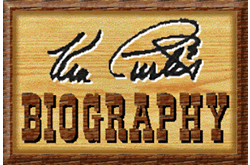
Curtis
Wain Gates, who would later adopt the professional name
of Ken Curtis, was born on July 2nd 1916 in the small southeastern
Colorado town of Lamar. |
| Lamar
Colorado, unlike Rome, was built in a day… on May 24th
1886. A legal dispute regarding a prospective town site
had arisen between the Santa Fe Railroad and a rich local
landowner, who owned the property on which the train depot
then stood.
|
|
The landowner had gone
to Denver in order to acquire an injunction to be issued
on the Monday. On Sunday the railroad men dismantled the
old depot, constructed a new one three miles away and
declared it to be the new town of Lamar. It was named
for the then Secretary of the Interior, Lucius Lamar,
in a successful attempt to legitimize the establishment
of the town.
Young Curtis was raised
in nearby Las Animas, Colorado. “I grew up 100 miles
from Dodge City, across the Colorado line from Kansas,”
said Ken.
His father, Dan Gates, was a homesteader and eventually
became the county sheriff. “I was 12 when Dad was
elected,” Curtis said in 1967 interview. “Our
living quarters were on the ground floor and the cells
were upstairs. Mother [Nellie Sneed Gates] used to cook
the meals for the prisoners and I took them up to the
cells while she held a shotgun in her hands in case any
of them got frisky.”
|
| |
Purportedly, he also acted
as deputy in his father’s absence.
Little is now known [by me, at any rate] of Curtis Gates’
adolescence: he played saxophone in a high school band
and later attended Colorado College in Colorado Springs,
studying medicine. However, he found he had more of an
aptitude for singing and songwriting. He left college
and headed for LA to try his luck in the music business.
He became a staff singer for NBC radio.
|
|
A TV
Land fan who spoke with Ken in the post Gunsmoke years,
describes the account which Ken gave of those early days.
“Several years ago Mr. Curtis was in Little Rock
signing autographs. A friend of mine and I went to see him.
[We] knew he sang with Tommy Dorsey and we started talking
with him about that. He hadn't thought about some of our
questions in a long time and invited us to sit down with
him and talk. Mr. Dorsey's theme song was I'm getting
Sentimental Over You. We asked him if there were any
words to the song as we had only played the song as an instrumental.
He smiled and sang the song for us at the table.
“In our conversation he related how he broke into show
business. He left Colorado to be a songwriter in Los Angeles.
It didn't take long for him to realize that he was not good
enough to break into the music scene in that manner. He
then hooked up with a small band and started to sing. One
night at a performance in attendance was Cecil B. DeMille’s
secretary. She liked Mr. Curtis' singing so much that she
suggested to her boss that he be hired to sing on the MGM
lot for visitors. About this time [Wizard of Oz composer]
Harold Arlen had written a new song he wanted to sell to
one of the Big Bands. He heard Mr. Curtis sing and paid
him a small amount to record his song. Mr. Arlen then sent
the record to the main Big Bands of the day hoping they
would buy and record his song. When Tommy Dorsey heard the
record he didn’t like the song but he loved the voice
of then Curtis Gates. Frank Sinatra had just left the band,
so he called Curtis and sent him the money to take the train
to New York. Since Mr. Dorsey did not like the name Curtis
Gates he had him change his name to Ken Curtis.”
– Robert Franks |
“I
joined Tommy Dorsey at the Paramount Theater in New York
as a singer," Ken later stated. "I replaced Frank
Sinatra.” Exactly what he meant by “replaced”
and for how long is a little unclear. (You can find a more
in depth investigation into the matter here.)
Apparently, it was a temporary replacement and he was subsequently
lent to the Shep Fields Orchestra. The
newly dubbed Ken Curtis’ budding Big Band career was
cut short when he joined the Army, enlisting in the infantry
in 1942. He served in the Pacific and was discharged in
1945.
|
|
|
|
Ken picked up his singing
career again doing guest spots on radio and the stage.
One such spot, for which he was reportedly recommended
by friend and fellow Tommy Dorsey singer Jo Stafford,
was on a radio show hosted by composer Johnny Mercer.
[Probably Johnny Mercer’s Music Shop.] On
the program he performed “Tumbling Tumbleweeds”
and attracted the attention of Columbia Pictures. They
cast him as their newest singing cowboy.
In 1945 and 1946, Ken
made eight “western action musical” films with
Columbia, which costarred a popular novelty singing group
called the Hoosier
Hot Shots. “What we had to sell was a product
called stupid,” one of the Hot Shots once
admitted.
|
“Stupid”,
however, was just as big then as it is now and the roughly
one hour long B films did rather well. The plots offered
little variety. There was always a girl, a ranch (or hotel
or radio station), a villain who wanted both, a comic sidekick
(often Guy
Kibbee), Guinn
"Big Boy" Williams and the helpful Hot Shots.
|
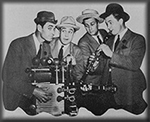
|
|
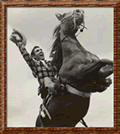
Singing on the Trail
(1946)
|
Apparently operating under
the theory that cowboy stars could only be counted on
to answer to their own names, Ken’s character was
called Curt in a majority of the films. He later dryly
commented on these early roles: “I’d stop in
the middle of a gun fight and sing a song.”
By 1947 Ken’s Columbia
contract had ended and the Singing Cowboy era had begun
to wane. For the next two years or so Ken worked
mainly in radio with programs
such as Hollywood Barn Dance and All Star Western
Theater.
|
In 1949 Ken’s film
career was partially revived when he starred in a few
independent low budget westerns, including Riders of
the Pony Express. The most significant career move
for him that year, however, was joining The Sons of the
Pioneers as lead singer. He was a good fit for the long
established western singing group “Of course, western
is my native music,” he said in a 1978 interview.
Besides recording, touring and a radio show (The Lucky
U Ranch program), The Sons of the Pioneers did soundtrack
music for the John Ford films Wagon Master (1949)
and Rio Grande (1950).
|
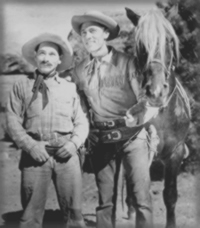
Ken Curtis and Shug Fisher
Riders of the Pony Express
|
They also
appeared in the latter. Ken’s part in the film was
somewhat larger than the rest of the Sons and even included
a few lines. Apparently he made quite an impression, capturing
a role in director John Ford’s next major project,
The Quiet Man (1952). He also snagged the director’s
daughter: Ken Curtis and Barbara Ford married in 1952.
|
|
|
In 1953 The Sons of the
Pioneers left their record label RCA-Victor because of
slow sales and signed with Coral Records. At this point
Ken decided to leave the group. The usual explanation
given for his decision is that he left to pursue film
and television projects. Judging from his credits, this
would seem to be inaccurate. He didn’t make any films
in 1953 or 1954 and did not begin his television career
until 1959.
[Perhaps he just went
on a really long honeymoon.] When the Sons returned to
RCA in 1955, Ken rejoined them, but only for studio work,
not touring. He soon left the group entirely.
|
| When
Ken Curtis returned to films in 1955 it was as a member
of his father-in-law’s “stock company.” He
worked on a dozen Ford films, usually in very minor roles.
His largest part was in 1956’s The Searchers
as Charlie McCorry. This role is sometimes referred to as
the progenitor of Festus, because for both parts he employed
what he called the “dry-land” accent, remembered
from his youth in the dry-lands of Colorado. (If you want
to buy The Searchers DVD just click the icon to the right. |
|
“I
was to be kind of a Ralph Bellamy,” Ken recalled in
a 1964 interview, “but I was kidding around on the
set, doing the dry-land dialect. I didn’t even know
Mr. Ford was listening. Then when it came time for me to
do my lines, he said, 'How would you say that in dry-land?'
I did it for him and he said, 'Play it that way.'”
According to a friend of his, that wasn’t necessarily
how Curtis would have preferred to do it. “Ken said
he never figured out whether Ford made him play it that
way because he was mad at him (which he usually was), or
just didn't want the character to be as strong as in the
book and diminish the Jeffrey Hunter role.”
|
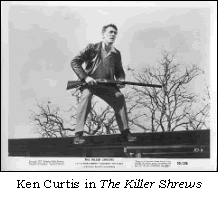
|
1959 saw
Ken’s career branch out in a couple of new directions.
In an unusual, but astute business move, Curtis formed a
production company and made a few very low budget films,
including The Killer Shrews (1959) and The Giant
Gila Monster (1959). The horror films were made in Texas
and intended to be released as a drive-in double feature.
The production costs were only a little over $100,000 per
film and the box office take was over a million. They are
now [quite rightly] considered “camp” classics
and were Ken still alive today he’d be raking in
|
| the
really big bucks from VHS and DVD sales. Both films have
been featured on Mystery Science Theater 3000, which
is definitely not a critical endorsement, but it has garnered
them a new generation of viewers.
As an actor
Ken is featured only in The
Killer Shrews and it is a must see performance.
If you haven’t already seen it, please do so before
reading this review.
[Very funny, but it does give away all the plot points.]
You can click above or on the movie poster to the right
for an Amazon merchandising link.
|
|
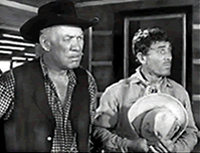
Ken
Curtis and Ward Bond in
Wagon Train
|
In
1959 Ken also began making appearances on the small screen.
His first role was, fittingly enough, on Gunsmoke
in the half-hour long episode “The Jayhawkers.”
He followed that up with another Gunsmoke role and
multiple appearances on Have Gun will Travel, more
Gunsmoke, Perry Mason and Wagon Train.
One of the episodes of Wagon Train on which he guest-starred,
“The Colter Craven Story”, was directed by John
Ford, who very rarely did television, and featured an appearance
by John Wayne.
|
Ken Curtis’ first
stint as a TV series regular was, rather surprisingly,
not on a western. The show was Ripcord, a half
hour syndicated adventure about skydiving heroes, which
debuted in September 1961 and had a 76 episode run. The
series costarred Larry Pennell and fellow Son of the Pioneers,
Shug Fisher. (Both actors would later have recurring roles
on The Beverly Hillbillies as Dash Riprock and
Shorty Kellems, respectively. Fisher also made numerous
guest appearances on Gunsmoke and costarred in
The Giant Gila Monster.)
|
|
Ken later
spoke exuberantly of the series: “We did some jumping
at the start of the show," he said. "We went out
without telling anyone—and the studio like to kill
us. They were threatened with cancellation of their production
insurance. I would have gone into it as a sport, but in
this business it's too risky. You break a leg and 150 other
people are out of work while production is shut down. It's
not like you were an accountant and could still work with
your leg in a cast. The scenes in the show were filmed with
a crew of really excellent stunt jumpers, but we had the
feel of the parachutes, so we could be more realistic in
the roles,” he said.
|
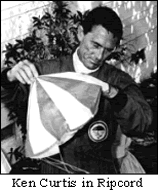
|
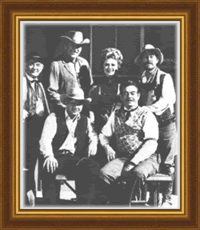
|
Ken Curtis made his first
appearance as Festus Haggen on Gunsmoke December
8th 1962 in the episode “Us Haggens.”
James Arness recently
recalled how 'Festus' came to be: “Andy McLaglen,
who had directed many of our shows, knew Kenny and had
worked with him before [on Have Gun, Will Travel].
“He decided to bring this character in for one show
and try it out. And he just seemed to feel right. He [Curtis]
had charm,” said producer Norman MacDonnell, who
already knew of Dennis Weaver’s desire to leave his
role as Chester.
|
| “Later
we had him do another and liked him even better.”
Weaver’s
departure in 1964 was the first major casting change the
show had undergone in it’s nine year history. “I
don’t think anybody felt comfortable about it,”
says James Arness. “Why fool with something that’s
successful, you know? And we were all wondering what would
happen at that point. Just take him out of the show and
what happens?”
Ken was waiting in the wings ready to fill the gap left
by Weaver. “It worked out great,” Arness commented
“It was interesting, because he [Ken Curtis] was able
to take over for Dennis, but yet he was different enough
so that it wasn’t like a repetition or something. He
actually created his own character.”
Audience
reaction to Festus was largely positive. “The mail
on Festus is either absolutely white or absolutely black,”
MacDonnell said in a 1964 interview. “Some people say
they can’t stand him. Others say they like him better
than Chester. They either love him or they hate him –
but 90 percent say they love him.”
Ken was
just glad to have the part. “There are so many good
actors that are hurtin’,” he said at the time.
“I’m just grateful. I hope Gunsmoke goes
on for another 10 years.”
Well, he
was pretty darn close. The show, and Festus, would go on
for eleven more years.
|
|
The year
he signed on to Gunsmoke, Ken and his second wife
Barbara were divorced. It was also the year in which he
made his last John Ford film and John Ford made his last
Western, Cheyenne Autumn. It was, in fact, the only
movie Ken made during the 11 year Gunsmoke run, with the
exception of the voice-over role for the Disney animated
feature Robin Hood (1973). Apparently, the Gunsmoke
shooting schedule and personal appearance tours left little
time for other projects. It may also have been the case
that he was so strongly identified with the role of Festus
that finding other work was difficult. If so he didn’t
find it cause for complaint. “I wouldn't care if they
tattoo 'Festus' all over,” he said. “He's been
good to me.”
|
|
|
In 1966
Ken remarried. He and his bride, former rodeo secretary
[and no, I don’t know what a rodeo secretary does] Torrie
Connelly, honeymooned at the Thunderbird Resort in Las Vegas.
Torrie was later asked to comment on her husband and Festus:
“Actually the two are one and the same. The only difference
between them is Ken's clean and well educated. He's kind
and gentle, and he loves children,” she said. “When Ken
would study the scripts for the next day's shooting, I could
tell when he read his lines—because he'd squint that eye.
He didn't even know he was doing it.”
Although Festus was used in many episodes (particularly
later ones) simply for comic relief, 11-years gave him ample
time to imbue the character with depth and nuance. “He
was a fine actor,” says James Arness. “I watch
the old shows now and he gives great performances. He does
some very serious shows actually and he was great. He was
able to add pretty much all the comedic stuff that Dennis
had, but in addition to that they had him doing, as I said,
many more serious character things.”
Ken’s own enthusiasm for Festus and the show never
seemed to waver. “I'm really proud ofGunsmoke.
We put on a good show every week—one that families
could all watch together without offending anyone.”
|
![[longbranch]](graphics/Gunsmoke3.gif)
|
In 1975
Gunsmoke ended it’s 20 year run. It still holds
the record for longest running scripted series on television
and reruns are currently being broadcast on at least three
cable networks [TV Land, Encore Westerns Channel and Hallmark
Channel.] The break wasn’t easy for Ken. “I
really miss Gunsmoke,” he said. "It was
like losing my whole family.”
|
After Gunsmoke wrapped,
Ken Curtis continued his association with Festus and took
him on the road with “The Dodge
City Four.” The group played fairs and rodeos
across the country from 1974 to 1978. “I'm reading
a lot of scripts these days,” he said at the time.
“With all these deals and commitments it gets complicated.
I have commitments to play Festus at all these fairs,
so the problem is shaving for parts.”
|
|
He took
on a few roles, mostly guest starring in western themed
television series, in the late 70s and early 80’s including
How the West was Won with James Arness. Pony Express
Rider (1976) and Lost (1983) marked his last
two appearances in feature films. “I've thought about
doing other dramatic roles besides westerns,” he admitted,
“but I grew up in the West and I know the West.”
In 1981
Ken was inducted (as was the rest of the Gunsmoke cast)
into The Hall of Great Western Performers of the National
Cowboy and Western Heritage Museum (a.k.a. The
Cowboy Hall of Fame.) At the museum portraits of the
Gunsmoke cast are accompanied by a collection of items from
the set of the series, which includes one of Miss Kitty's
(Amanda Blake) green dresses, Doc's (Milburn Stone) director's
chair and the saddle Festus (Ken Curtis) rode on his mule.
|
| ![[Texas Guns]](graphics/TexasGuns2.jpg)
Once Upon a Texas Train
Dub Taylor, Royal Dano, Gene
Evans,
Ken Curtis and Willie Nelson
|
In the 1983-84 television
season Ken costarred as ranch hand Hoyt Coryell on the
short lived but critically lauded [that means I liked
it] series “The Yellow Rose” with Sam Elliott
and Cybill Shepherd.
After the series ended
Ken more or less retired, doing occasional personal appearances
and autograph signings He made only four more television
appearances: Airwolf (1986), Once Upon a Texas
Train with Willie Nelson (1988), In the Heat of
The Night (1990), and Conagher (1991) with
Sam Elliott, which was broadcast after Ken’s
death.
|
Ken
Curtis died in his sleep at his ranch in Clovis California
on April 28th 1991 of a heart attack. His ashes were scattered
in the Colorado flatlands where he was born. |
![[statue title]](graphics/StatueTitleCard.gif)
In February of 1992 the
city of Clovis unveiled the Festus Statue created by local
artist Sam Hutchings.
Until recently it stood in "Old Town" outside
the Clovis Big Dry Creek Historical Museum. Inside, the
museum features some of Ken Curtis' personal memorabilia
as well as local historical items.
The statue has now been moved
in front of a local bank, because the museum is currently
undergoing construction. The
citizens of Clovis take pride in the landmark: “Ken
'Festus' Curtis embodies all the wonderful attributes
held by our Clovis citizens and even more,” said
Clovis historian Ron Sundquist. “He is the symbol
of a great hero, so needed by everyone young and old.”
|
![[statue and bank]](graphics/FestusStatue2.jpg)
Festus, now guarding
the
Educational Employees Credit Union
|
|
|
Sam Hutchings
sculpted the Festus Statue in 1991. “I feel very blessed
to have been able to do the memorial of Ken Curtis. I am
a 56 year old grandmother. And art is my life.”
“Torrie Curtis, Ken’s wife, brought me everything
that I needed to make the statue. Such as his boots, holster,
hat and such. She gave me several pictures of him and brought
me a bust made of him by another artist. Torrie taught me
a lot about Ken. We used to sit and just talk about him,
her doing it to relieve her grief of losing him. She loved
showing me special things of his that he loved.
|
|
“I
did the statue out of Cement and rebar. I hand molded it
from the feet up. It took about 5 months to make. Working
in cement is heck on the hands and you have to be pretty
patient. It's a lot of fun though, and the reason I ever
got started working with cement is it seems so everlasting.
I know the statues will last a lot longer than I will.
|
|
“The
day I felt it was finished, Torrie and her daughter and
granddaughter came out to my house. When they pulled in,
her granddaughter said “Look Grandma, there's Grandpa!”
When the car stopped Torrie and her daughter were crying.
And of course I started crying too, especially when they
told me what she said. About two weeks later we had the
unveiling. I donated the statue to the City of Clovis.”
|
![[unveiling]](graphics/FestusUnveiling.jpg)
Sculptor Sam at the unveiling You
may contact Sam at sammersss@att.net
|
![[bibliography]](graphics/WebTitleCard.gif)
Click
Here

|
|